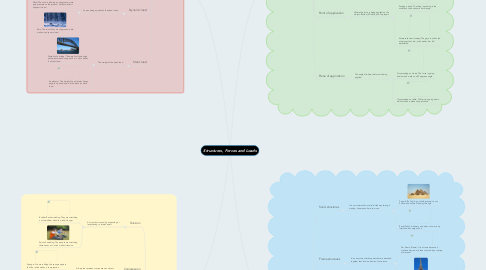
1. Types of structures
1.1. Solid structures
1.1.1. It is a structure that is solid all the way through making it heavy and hard to move.
1.1.1.1. Pyramid (Solid): It is a solid because it is not hollow and solid all the way through.
1.1.1.2. Rock (Solid): It is heavy and does not move by itself and has weight on it.
1.2. Frame structures
1.2.1. It is a structure that has parts that are attached together that forms a frame of a structure.
1.2.1.1. Car Frame (Frame): It is a frame because it makes a frame but is then covered by a coating of material.
1.2.1.2. Eiffel Tower (Frame): It is a frame because it has holes in it and is carved to make a shape.
1.3. Shell structures
1.3.1. It is the most strongest structure. It is also hollow so it uses very little materials.
1.3.1.1. Egg (Shell): An egg is a shell structure because it is hollow and can hold stuff in its hollow shell.
1.3.1.2. Sydney Opera House (Shell): This is a shell structure because it is hollow all the way through.
1.4. Combination structures
1.4.1. It is a combination of the other 3 different types of structures. It can be hollow, strong, heavy and cab be attached together like frames
1.4.1.1. House: A house is a combination structure because the people make a frame before building, then add bricks and walls witch makes it a solid. Also it has room to keep stuff in it, so its a shell.
1.4.1.2. Building: This is a combination structure because it has a frame, is hollow to hold stuff, and solid from the walls and bricks.
2. External Forces
2.1. Magnitude
2.1.1. It is a measure of how strong and fast a force on something can be.
2.1.1.1. Soccer Ball being Kicked: The soccer ball is being kicked strongly because the foot is coming in fast. This is magnitude.
2.1.1.2. Wrecking Ball: The wrecking ball was coming in fast, witch made it stronger, witch made a hard impact on the wall.
2.2. Direction
2.2.1. Where the force is being applied:
2.2.1.1. Pushing on a Swing: The force is a push witch makes the kid go far, witch makes it direction.
2.2.1.2. Pulling on hair: She is pulling the hair witch makes the force go up. Witch makes it direction as well.
2.3. Point of application
2.3.1. Where the force is being applied on the object: Bottom, Middle, and Top layers
2.3.1.1. Pushing a book: The thing is pushing in the middle so the books are not moving.
2.3.1.2. Karate take down/sweep: The guys foot hits the other guys foot low, witch makes him fall backwards.
2.4. Plane of application
2.4.1. The angle of where the force is being applied
2.4.1.1. Guy standing on Horse: The force is going down which makes it a 90 degrees angle.
2.4.1.2. Guy standing on table: The force is going down which makes is plane of application.
3. Types of Loads
3.1. Live load
3.1.1. The weight of a moving load being put on a dead load.
3.1.1.1. Car on road: The car is moving and putting force on the road, witch makes it a live load.
3.1.1.2. Apple on Table: The apple is getting supported by the dead load witch was the table, so its the live load.
3.2. Dead Load
3.2.1. A load that supports a live load.
3.2.1.1. A bridge: The bridge holds up all the cars moving by, witch makes it the dead load.
3.2.1.2. A road: The road does not move and gets forces acted on it, so that makes it the dead load.
3.3. Dynamic load
3.3.1. Forces being applied to the dead loads.
3.3.1.1. Wind: The wind is blowing on the ground witch puts pressure on the ground. So that makes it a dynamic load.
3.3.1.2. Rain: The rains falls onto the ground witch makes it a dynamic load.
3.4. Static load
3.4.1. The weight of the dead load
3.4.1.1. Weight of a bridge: The weight of the bridge puts pressure and supports on it, witch makes it a static load.
3.4.1.2. An elevator: The weight of an elevator brings people up and down, witch makes it a static load.
4. Internal Forces
4.1. Ternsion
4.1.1. A force that is used by expanding or lengthening to stretch apart
4.1.1.1. Rubber Band stretching: They are stretching out the rubber band to make it longer.
4.1.1.2. Person Stretching: The people are stretching there bones out, witch makes it tension.
4.2. Compression
4.2.1. A force that presses or squeezes an object together
4.2.1.1. Sponge: You are rubbing the sponge against the floor witch makes it compression.
4.2.1.2. Stress Ball: You are squeezing the ball witch makes it Compression.
4.3. Torsion
4.3.1. A force that twists
4.3.1.1. Towel: The towel is twisting witch makes it Torsion.
4.3.1.2. Rope: The rope is twisted witch makes it torsion.
4.4. Shear
4.4.1. When two objects push against each other but each going in the opisite direction
4.4.1.1. Rubbing hands together: Both hands are against each other rubbing in separate directions.
4.4.1.2. Pencil on Paper:The pencil is moving back and forth witch makes it Shear.

